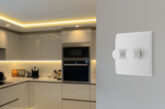
Josh Hammerton, Technical Director at Enkin, answers some of the most frequently asked questions around dimmers and dimming technology.
Dimmer technology has revolutionised the way we control lighting in our homes and offices. As a crucial aspect of modern lighting systems, dimmers offer versatility and energy efficiency. But as technology evolves, electricians often encounter uncertainty when selecting the right dimmers for lighting setups.
Here, I aim to shed some light on those common queries that we encounter around dimming technology:
Q. What is the difference between leading edge and trailing edge dimmers?
Leading edge and trailing edge refer to the points in an AC waveform where the dimmer cuts off the voltage to the light. Leading edge dimmers cut the voltage at the beginning of the waveform, while trailing edge dimmers cut it at the end. Leading edge dimmers are often considered traditional dimmers and are suitable for incandescent and halogen bulbs. They work well with resistive loads but may not be ideal for some LED lamps. Trailing edge dimmers are the modern solution to older dimmer technology, working well with LED and CFL bulbs. They provide a smoother dimming experience and are generally more compatible with electronic transformers.
Q. Can dimmers save energy for customers and end users?
Yes, dimmers can contribute to energy savings. By reducing the brightness of lights, dimmers consume less power, leading to lower energy bills. However, the actual energy savings depend on factors like the type of bulbs used, the dimmer technology, and the overall lighting system size, as well as efficiency.
Q. What is multi-location dimming?
Multi-location, or multi-way dimming, refers to the ability to control and dim a single set of lights from multiple locations. Up until recently, this has been achieved through a master/slave configuration and the use of compatible dimmer switches. It’s a convenient solution for large rooms, hallways, or staircases where light control is needed from various entry points. However, this technology for multi-location dimming has been rather limiting, with most multi-location dimming switches only reaching a maximum load of 100 W, meaning a smaller overall light setup.
Q. What if I need a larger lighting scheme to work through one set of multi-way dimmers?
With an Enkin PDM250 multi-way dimmer, there is no limit to how many dimmer switches you could have to control the same lighting system. Unlike a traditional master/slave setup, these multi-way dimmers reach a maximum load of 250 W, which means you can adjust the brightness of a much larger light setup, all on the same circuit.
Q. How do I use the Enkin PDM250 dimmer in my project?
The beauty of the PDM250 module is that there is no need for a master and slave switch setup. When setting up the PDM250 modules for multi-way dimming, wire as per the wiring diagram that shows one module with the live feed in, and load feed out. Then wire the remaining PDM250 modules in parallel to the first on the same circuit. This allows the same setting and dimming position to be shared across all dimmers on that circuit.
Q. How should I then go about setting it all up?
Enkin prides itself on its user-friendly, simple button setup. You can set the lowest level of light, the maximum level of light, reset the levels, and change the driving mode, all through the use of one button on the rear of the module. Not only does this mean a quicker setup, but it makes for a confusion-free installation.
Visit the Enkin PDM250 Multi-Way Dimmer product information page here









